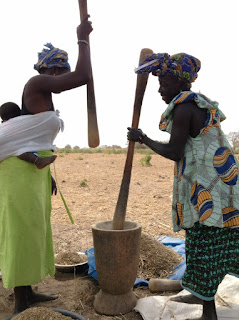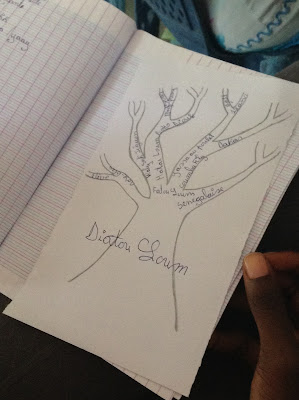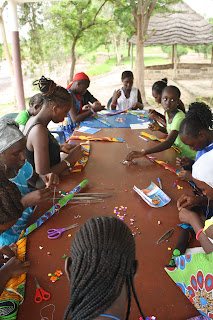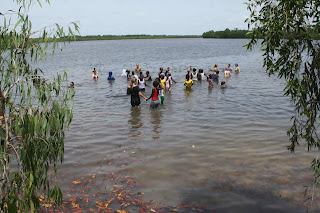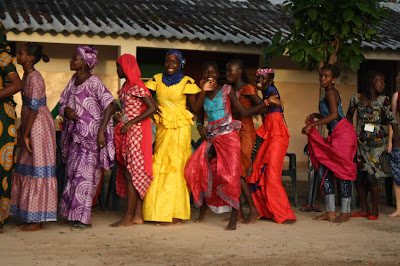Waiting nervously to interview for a
position in the Peace Corps I sought reassurance in the cheerful, brightly
colored slogans around me,
"There isn't an app for this,"
"Here's your wake up call,"
"The toughest job you'll ever love."
"The toughest job you'll ever love."
But these sayings in no way prepared me
for my service... or what I'd learn.
I stepped off the plane into the rich
Senegalese culture,
learning to love the ‘lunch bowl,’
the kindness of host families,
to greet in my halting Wolof,
and to laugh at my faux pas.
The gardens of the training center became
my classroom where I studied daily,
learning to identify pests and rot,
about Senegal's environmental woes,
to recognize West African crops at a
glance,
and how to graft trees.
I swore in as an official volunteer and
moved into a small village,
learning to live in a hut,
make do without toilet paper,
sleep under the stars,
and eat with my hand.
I earned my village education from my new
neighbors,
learning to pull water from a well,
balance full buckets on my head,
pound millet in an enormous mortar and
pestle,
and dance in a circle of clapping women.
Without my American driver’s license I
was thrust upon the Senegalese transit system,
learning to squeeze into rickety
sept-places,
hang off the back of buses,
bargain for seats in bush taxis,
and bike beneath the baobabs.
But even as I integrated, by body
struggled to adapt,
learning to keep hydrated,
the meaning of a 'brown star,'
parasites' effects,
and the true power of sunscreen.
Then hot season was upon us and I
acquired new survival skills,
learning to take shelter in dust storms,
sweat through 122⁰ weather,
sidestep scorpions,
and kill camel spiders.
The heat made time slow and I slowed with
it,
learning the art of an afternoon spent under
a mango tree,
to build callouses from shelling peanuts,
the necessity of hand fans,
and to drink endless rounds of tea.
But my village wasn’t the only community
I’d been welcomed into,
learning that no one is as supportive as
a fellow volunteer,
pouring our hearts out to each other as
we lay on hut floors,
bonding through our shared homesickness
and rustling up veritable feasts for
American holidays.
When the rains came I watched the daily
rhythms change,
learning to plow in a straight line,
weed hectar-sized plots by hand,
sway during rain dances to ward off
droughts,
and the feeling of true food insecurity.
My job was unlike anything I’d done
before,
learning to advise farmers in muddy
fields,
apply for grants,
oversee the construction of wells,
and write youth camp curricula in
multiple languages.
My host family and I embraced multiculturism
in the face of growing global division,
learning to fast during Ramadan and
celebrate Christmas,
about the attacks in Paris, Mali,
Brussels, and Cote D’Ivoire,
that ‘different’ isn’t synonymous with
‘bad,’
and to begin and end each day with ‘peace
only.’
Then my two years were up but I decided
to stay,
learning to welcome the next generation
of volunteers,
teach them about agriculture,
assuage their fears,
and see Senegal anew through their eyes.
I moved out of village and into Dakar,
learning the pace of city life,
the difference between 'village' and
'office' culture,
to trade baobabs for seaside views,
and the overwhelming amount of choice in
a grocery store.
And then 31 months had passed and I was
saying goodbye,
learning to hug away friends,
wish luck to those I’d mentored,
blink away tears on a last trip to village,
and understand the finality of a
left-handed handshake.
So thank you Peace Corps.
In my time here I have learned so
much.
I learned to try the new,
and embrace the unexpected.
I learned to fail,
to laugh at myself,
and to be comfortable in my own skin.
I learned to meet new people,
to observe them,
to join them,
to love them.
In the Peace Corps I learned about
Senegal,
I learned about myself,
but mostly I learned how much there is to
learn.

























